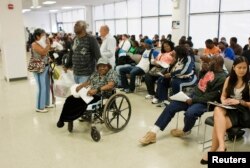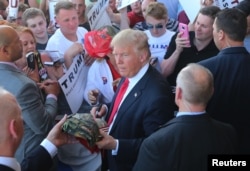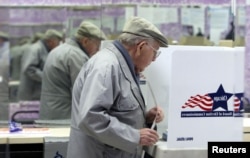In about six months, the most diverse American electorate in history will vote for a new president, a demographic shift that analysts say is happening faster than expected.
"By the 2016, 22 states in America will be 'majority-minority,'" said Karlyn Bowman, a senior fellow at the American Enterprise Institute, and one of the authors of "States of Change - Demography and Democracy," a study published earlier this year.
The growing ethnic and racial diversity of America has profound implications for the country's politics, and some say it is already reflected in this year's charged presidential campaign season.
Republican front-runner business mogul Donald Trump has criticized policies that have allowed millions of undocumented immigrants to live and work in America. This sharp campaign rhetoric is considered by nervous members of the Republican mainstream as a risky political strategy.
According to a survey by the Pew Research Center published in February, nearly one-in-three eligible voters on Election Day (31 percent) will be Hispanic, Asian, black or another racial or ethnic minority, up from 29 percent in 2012.
Bowman points out the demographic surge of minority populations is "emerging much faster than we expected," based on data reported by the U.S. Census data from the year 2000 to 2010.
Non-hispanic whites remain the largest major race and ethnic group, but is growing at the slowest rate of all groups — just 1 percent from 2000 to 2010. During that same time, the Hispanic population and the Asian population grew by 43 percent.
The speed of these demographic changes has created a “cultural identification gap” argues Brookings Institute demographer William Frey, author of the 2014 book Diversity Explosion.
He puts it this way:
“The older population, which is largely white, has some trouble dealing with the changing demographics in the country.”
It is a polite way of saying that many who support Trump’s dramatic political rise — white with less formal education and hard-hit by the 2008 recession, according to polls — have expressed strong resentment about the explosion of minorities.
Trump’s critics are calling foul, openly accusing him of knowingly stoking anger and dangerous divisions with no concern for the possible consequences.
Among them: Charles Badger, a former staffer for Republican Jeb Bush's failed presidential campaign, and author of the article “Trump’s Secret Plan to Win the Presidency: Pitting Minorities Against One Another.”
Badger argues that a thoughtful look at history tells us much about Trump’s tactics to win the Oval Office.
“He follows a long line, a long tradition, of demagogues like him who have done exactly what he is doing now … because it’s a tried-and-true model.”
Add the that, Badger said, the current alignment of the stars economically.
“These sort of demagogic figures always sort of arrive — not just in our country, but any country whenever you have the vast changes in population,” argues Badger. “The best way that Trump can be understood. … This wave of support he is riding is backlash support — and it’s not just immigration — it’s a reaction to changes in the country.”
The recession may be over per the measuring sticks used by top economists, but that doesn’t mean the effects of the 2008 financial crisis have disappeared.
Many Americans — and, according to pollsters, Trump’s supporters — are still struggling to make ends meet.
They work low-paying jobs with few benefits, they are saddled with debt, lack access to higher education: In short, they are living without a clear path to improve their lot in life.
Trump’s in-your-face style (not unlike Democratic candidate Bernie Sanders anti-Wall Street message) speaks directly to that segment of the voting population who live the reality of being left out of the so-called “American Dream” economy.
A winning strategy?
This openly aggressive “pro-white” strategy may not be the most effective, according to Frey.
That’s because white Americans are aging, and soon will be dying in larger numbers than producing children. In other words, whites need these young minorities because they will soon make up a big chunk of America’s working population.
Put more starkly, older white Americans will very soon need the money that Hispanics, Asians and African-Americans will generate as part of the U.S. labor force.
As to Trump’s undeniably ugly comments about immigrants and other groups, Frey is practical, pointing out that immigration is not, by far, the reason that minority communities are growing by leaps and bounds.
“Politicians always try to paint pictures that they see will help them get more votes," said Frey, who has some advice for those seeking elected office.
“Moving forward, votes are going to be with minorities, not with older whites.”
















